** If your not so much of a reader then there is an image gallery of the whole trip at the bottom of the post. Please email if you want more details or to repost this article: davesearleguiding@gmail.com **
What a trip.
I’ve never really had (or made?) the chance to ski outside of the Alps. Having the privilege to have lived in Chamonix for the past 11 years has meant that 99% of my skiing has been around the area, apart from a few days in Scotland. Skiing close to home has its pros and cons. Pro: It’s quicker and easier to get to the ski hill so I can try to have a smaller carbon footprint. Con: I often end up skiing the same runs, meaning some of the classics have lost their magic and appeal. Pro: It’s very easy to get a lot of exposure in order to improve your skills in ski mountaineering/steep skiing/freeride skiing/backcountry skiing or whatever you want to call it. Quite simply, the terrain and access we have around Chamonix is some of the best in the world. Con: Because it’s one of the best, it’s busy and almost everything has already been skied at some point, which means there is little to no true adventure left to be had.
When Ross Hewitt casually mentioned to me in the bar one evening that he was booking a trip to ski in New Zealand in the late Autumn (or spring if you live down there) my interest was piqued. I’d wanted to take a trip back there for a while ever since I went for a family trip when I was 17 where we did the typical tourist itinerary: driving around in a campervan, sight-seeing, and bungee jumping. I remember being enchanted by the rugged landscapes and open spaces, vowing I’d come back at some point. I had no idea it would be skiing that brought me back. At that age though I had only done about three days of skiing in my life so it wasn’t yet on my radar.
Fast forward 14 years to late September 2019 and I’m sat at my computer in rainy Chamonix after what was one of the most emotionally and physically exhausting summer seasons I’ve ever had. I’m about to pull the trigger on a £1200 flight that I can barely afford. Completing the IFMGA guides course this summer took its toll on me not only physically and psychologically but also on my bank balance. ‘What the hell’ I thought. Click, game on!
Ross was due to fly out a week earlier than me and when he was at the Geneva airport I got a very flustered call from him… “Did you know we needed a visa to travel to New Zealand???” We had assumed that it being a commonwealth country, travel there would be straightforward. After scrambling to try and get an ETA (electronic travel authorisation) and failing to do so in time, he missed his flight. “It’s gone dude, I missed it. Apparently, the ETA is a new thing and it changed on October 1st”. My brain raced. ‘Do I still want to go and cobble a trip together without him? I don’t really know how it works out there and besides I could still get the money back for the flight.’ I hate not knowing what’s going on but for about 12 hours our whole trip was in up in the air.
Ross calls me the next morning and tells me he’s bought a new flight. It’s game on… Again!
Ross and I arrive in Christchurch within an hour of each other. Although the difference was Ross had his large ski bag, packed full of his ski mountaineering kit, while I had nothing. My heart sank as the last of the luggage was collected from the baggage carousel and I knew they weren’t going to show up. In my horrifically jet lagged state I panicked again that the whole trip was in jeopardy. The guy at the baggage counter was sure they would arrive during the night and I would have them the following day. Luckily he was right…
After being reunited with my bags the next day, we headed to a supermarket to do a monster shopping mission. We loaded in the skis, food, and kit into our tiny hire car and hit the road. Direction: Mount Cook Village.
Skiing in New Zealand in October could be likened to skiing in the alps in late April or May. The snow isn’t really reaching down to the valley and the temperatures can be pleasantly warm or freezing cold. When we arrived in Mount Cook Village we headed straight to the Wyn Irwin Lodge, which is owed by the Canterbury Mountaineering Club. This would be base camp for our trip and we sat out a few days of fairly horrific weather shortly after our arrival. Luckily, we had great company: Cam the hut guardian, Laura who worked for the Department of Conservation protecting Keas (mountain parrots), Tim who helped build some of the mountain huts including the Plateau Hut, and Beau, an American skier from Yellowstone who had done many trips to NZ before. Good conversations, beer, and a cosy hut is a great way to pass the time waiting for better weather and conditions. I started to get a little worried that we might just be stuck waiting out bad weather for our whole trip but then small windows of opportunity started to appear. We did a day tour from the hut up towards Sealy Tarns and the Mueller Hut. It felt great to get the skis on and get a few turns in but I was itching to get up high and do something bigger.
A few more days of bad weather passed and when I say bad I mean bad: gale force winds and huge amounts of precipitation. We saw a window of opportunity to get into the mountains and decided to fly into the Plateau Hut with a chopper. This is the main hut for climbing Mount Cook via the east side which is typically the more sheltered side of the southern alps. Ross, Beau, and I packed for an extended trip, which meant enough food for seven to ten days in the hut, all our ski mountaineering kit, and sleeping stuff. The hut is super well equipped with beds, gas stoves, running water (which froze from time to time), and a radio. Think basic mountain refuge in the alps, minus the guardian.
When we arrived in the helicopter outside the hut, we started to unload all our kit. In the frenzy of moving stuff around and the worsening weather we neglected to double check we had taken everything out of the helicopter. A duffle bag with our sleeping bags and Ross’s ski bag were left in the side compartment and we only realised once we had got into the hut and taken stock. They also had our satellite phone and both Garmin Inreach devices. We were stuck in the hut without a form of communication and without any sleeping or skiing kit. Bugger. Luckily, we were able to relay a message with the hut radio via the DOC (Department of Conservation who run the hut) explaining what had happened and about 20 minutes later, Inflite returned with the kit just before the weather fully closed in.
It was cold in the hut when we arrived, only a couple of degrees and very humid. It felt like Scotland with the high humidity and strong gusty winds. We waited out more bad weather for a day or so then it cleared and we got the chance to ski. We decided to head over to the East Ridge which splits the Caroline Face and the East Ridge to do some reconnaissance. We climbed up a feature on the East Face that we later dubbed the King Spine. It looked like the kind of terrain you see in Alaskan ski films and wading up the line took a lot of effort. The snow was waist deep in places but was light and fluffy and not at all wind packed or heavy. I was seriously surprised it felt so good especially after the wind and precipitation we received over the week before. We skied a run down and through the glacier. It was seriously good!
After that, we skied down from Cinerama Col to check out the Caroline Face. A few friends of ours had skied this mythical beast a few years ago and we wanted to see if it would go this year. It seemed a little icy at the top but the lower two thirds looked great. Whilst we were there, we spied a line off the back of the King Spine. At some 700m in vert, and with big wide 40-45 degree snow slopes, it looked inviting to say the least. We headed back to the hut happy with a good days skiing.
On Friday the 25th, after a day of poor vis and wind, Beau decided he was going to head off on a solo mission up the glacier to visit a couple of other huts. Me and Ross got up and headed over to try and ski Mount Dixon, but on the way up there I had a feeling it wasn’t going to be good. Dixon gets smashed by the southerly winds and it was looking icy and not that inviting. I persuaded Ross into taking a look at the line we had seen on the Caroline face. We scooted back down the plateau and headed up the King Spine again. Here’s what that looked like:
I was stoked! That day was probably one of the best days skiing I’ve had. Skiing somewhere where it is highly likely no one has been before on a mythical face of NZ’s highest peak. We were content with a few more days enforced rest back in the hut.
The weather as you can tell by now is a tricky beast out in NZ. We had a rope fixed to the toilet, which proved very useful on some occasions. You could literally get ripped off the side of the mountain on the short dash over to take a leak. The whole hut would vibrate and shake and the window seals, despite being rated to 400kph winds, would whistle and howl. If it wasn’t too windy it would sound like a curious owl but when it was bad the angry banshee made an appearance. One night it was so windy and snowy that it pushed snow through the window seals into the hut. On the wall of the hut there is a timeline of all the huts in NZ and a couple of decades ago one of them literally blew away with 4 people inside it. I would try and fall asleep and reassure myself that Tim and his fellow hut builders had done a good job and we weren’t about to get deposited on the Tasman Glacier a kilometre below in our sleeping bags.
We had some company to pass the days and played cards and chatted with the team of five that were staying at the hut doing an NZ alpine club course with guide Nick Cradock. Erica, Tim, Suze and Clair put up with mine and Ross’s terrible banter and proved to be formidable Shithead opponents.
My main objective for the trip was to ski the east face of Mount cook. This 1400m face is probably one of the most sought after ski lines in new Zealand and should be on any ski mountaineers bucket list. There is no easy way up Mt Cook and typically you climb and ski the line in a big day. They aren’t allowed to drop you off in a chopper on the top and even if they were, they couldn’t 99% of the time because of the wind. Ideally you should start early from the hut to ski when the sun is just softening the snow in the morning but not too much that it transforms into dangerous mush. Ross had already skied the line before but he was keen to ski it again and we set our sights on it. After a couple of aborted starts due to the weather I went to bed one night not knowing what the next day would bring. Maybe I’d read another couple of alpinist magazines in the hut or we might get another days skiing in. Who knows.
On Thursday October 31st, Ross woke me at 4.30am. “It’s clear out there and hardly any wind,” Ross said. “I think we should go for the East”. I’m out of bed and pulling on my ski pants in seconds. Would this be the day? Maybe we were too late already. We had thought that we should probably get up around 1am for this line. Let’s go take a look.
The wind had seemingly destroyed the snow. Sastrugi and windboard would be good descriptors for the snow surface of the glacier and my optimism for the conditions dwindled. Much to my surprise the snow on the face was much better. Also a thin veil of high cloud sheltered the face from most of the suns power keeping the snow crystals cold. We waded up 1200m of the face in boot to knee deep snow and made the difficult decision to turn around just below the summit ridge. There were patches of blue ice above and the cloud was building more and more. We both wanted a good ski more than reaching the summit and skiing the line completely.
The skiing was awesome. You could put big turns in and easily manage the sluff by skiing in a diagonal line across the face. I was really happy I got a chance to ski this line but I’ll be back one day to reach the summit for sure. It truly is one of the best lines I’ve ever been on.
Whist we were away that day, 14 other skiers appeared. It was quite the shock to the system going from it being just me and Ross to there being some 18 people in the hut (two alpinists had walked in the day before we skied the East face).
Ross wanted to ski the Caroline face the next day as it was likely the last day of good weather we would have on our trip. I was pretty unsure of the conditions, which need to be more or less perfect due to the exposure and committing nature of the face. It seemed like it was going to be too icy on the upper face to make a worthwhile attempt. Luckily one of the skiers who flew in, Mark Smiley, had a good quality picture of the face where you could see white ice with very little snow stuck to it. After we saw that, we decided that it wasn’t going to happen. I could tell Ross was disappointed and we had spent many hours talking about the logistics and conditions on that face but it was pretty clear it wasn’t the year for it. We decided to have a go making the second descent of the Bowie Couloir. This ended up being our last day skiing in NZ and it sure was a good one (video below). We flew out of the hut that afternoon and got appropriately drunk in the village in the evening.
To sum up, we had around five great days skiing out of a three-week trip. The cost of the flight down there was a lot more than anything else we had to pay for, but once we were there, we paid roughly £1000 each for all expenses. I was super impressed with the skiing and I’ll be back down there for sure. Thanks to everyone who was involved in making this trip what it was. See you next time!
** Click to enlarge the image and see in Slideshow. **

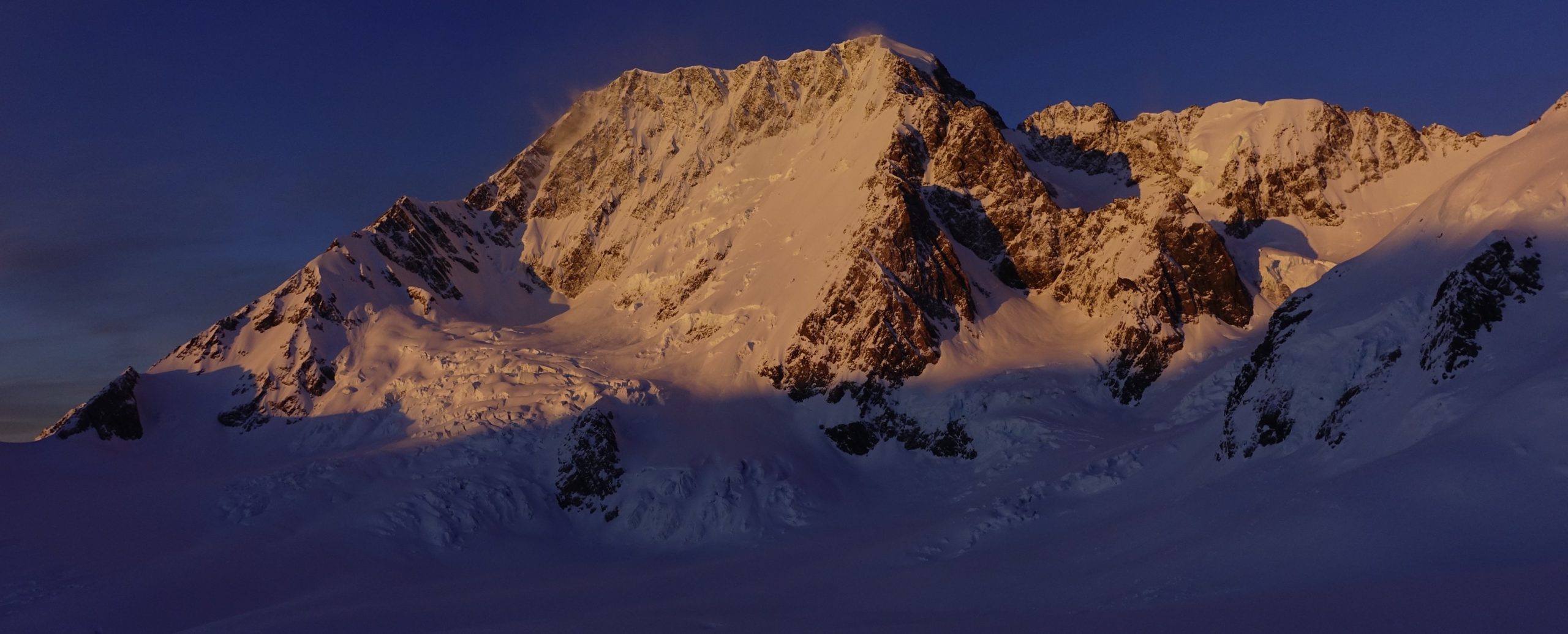
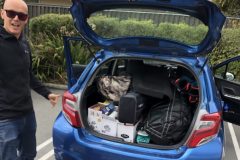
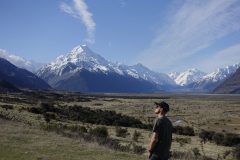
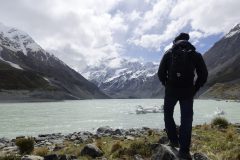
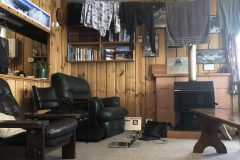
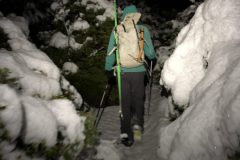
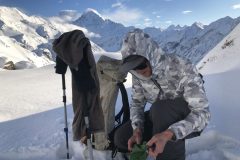
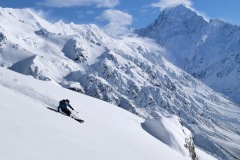
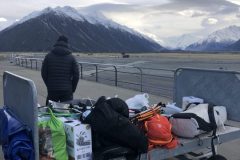
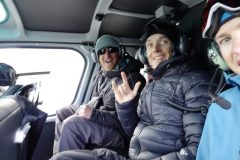
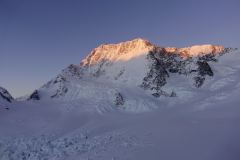
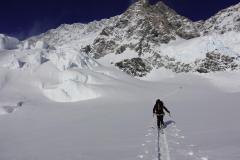
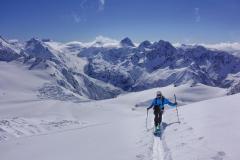
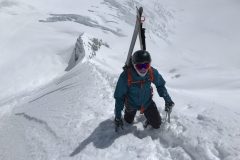
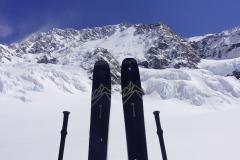
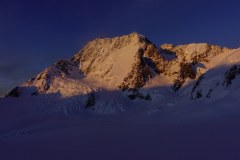
Hi Dave, nice account ! took me a while to figure it was you guys, in our vid when finishing your descent of the East face :
https://youtu.be/XTL1I0jq9jQ